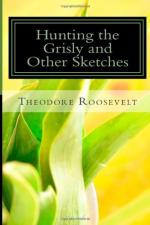In the spring and early summer of 1888, the bears killed no cattle near my ranch; but in the late summer and early fall of that year a big bear, which we well knew by its tracks, suddenly took to cattle-killing. This was a brute which had its headquarters on some very large brush bottoms a dozen miles below my ranch house, and which ranged to and fro across the broken country flanking the river on each side. It began just before berry time, but continued its career of destruction long after the wild plums and even buffalo berries had ripened. I think that what started it was a feast on a cow which had mired and died in the bed of the creek; at least it was not until after we found that it had been feeding at the carcass and had eaten every scrap, that we discovered traces of its ravages among the livestock. It seemed to attack the animals wholly regardless of their size and strength; its victims including a large bull and a beef steer, as well as cows, yearlings, and gaunt, weak trail “doughgies,” which had been brought in very late by a Texas cow-outfit—for that year several herds were driven up from the overstocked, eaten-out, and drought-stricken ranges of the far south. Judging from the signs, the crafty old grisly, as cunning as he was ferocious, usually lay in wait for the cattle when they came down to water, choosing some thicket of dense underbrush and twisted cottonwoods, through which they had to pass before reaching the sand banks on the river’s brink. Sometimes he pounced on them as they fed through the thick, low cover of the bottoms, where an assailant could either lie in ambush by one of the numerous cattle trails, or else creep unobserved towards some browsing beast. When within a few feet a quick rush carried him fairly on the terrified quarry; and though but a clumsy animal compared to the great cats, the grisly is far quicker than one would imagine from viewing his ordinary lumbering gait. In one or two instances the bear had apparently grappled with his victim by seizing it near the loins and striking a disabling blow over the small of the back; in at least one instance he had jumped on the animal’s head, grasping it with his fore-paws, while with his fangs he tore open the throat or crunched the neck bone. Some of his victims were slain far from the river, in winding, brushy coulies of the Bad Lands, where the broken nature of the ground rendered stalking easy. Several of the ranchmen, angered at their losses, hunted their foe eagerly, but always with ill success; until one of them put poison in a carcass, and thus at last, in ignoble fashion, slew the cattle-killer.
Mr. Clarence King informs me that he was once eye-witness to a bear’s killing a steer, in California. The steer was in a small pasture, and the bear climbed over, partly breaking down, the rails which barred the gateway. The steer started to run, but the grisly overtook it in four or five bounds, and struck it a tremendous blow on the flank with one paw, knocking several ribs clear away from the spine, and killing the animal outright by the shock.




